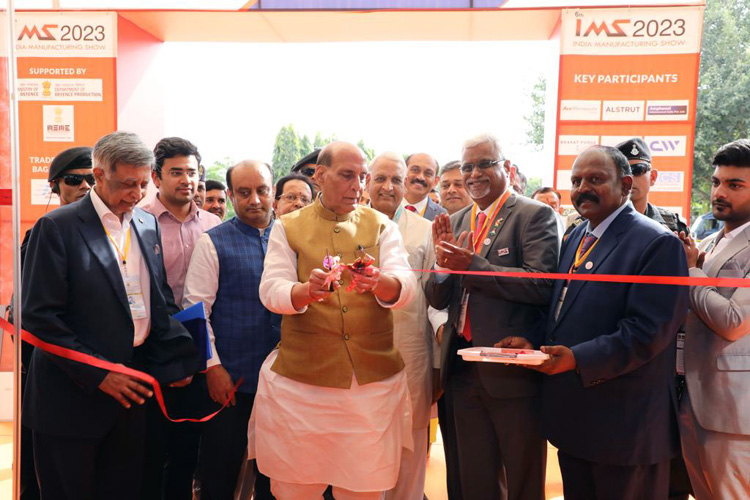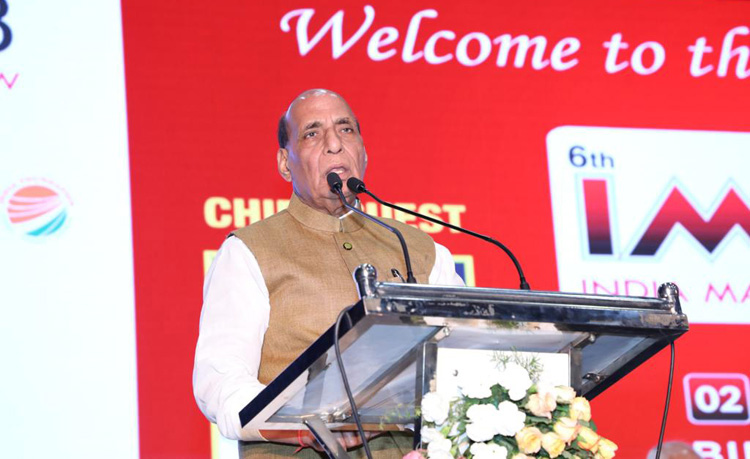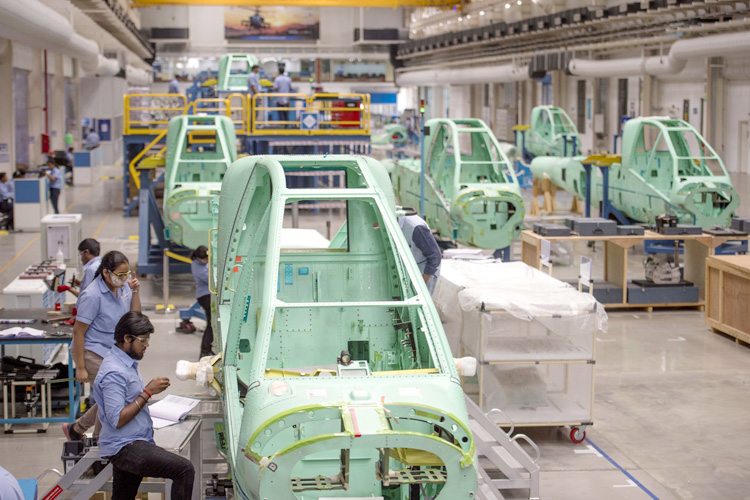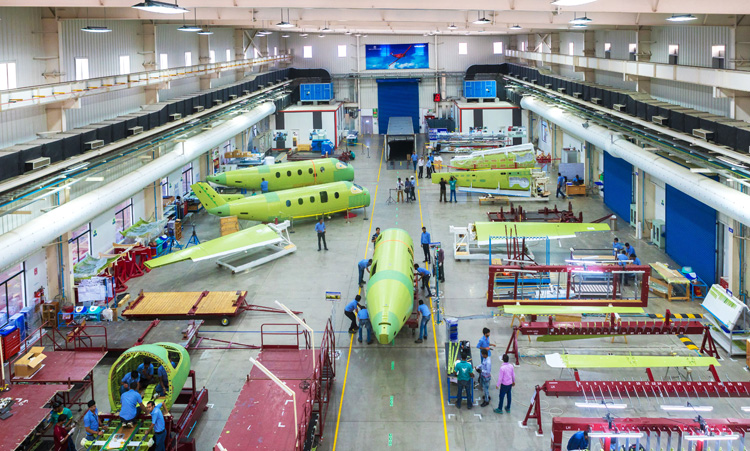INDIAN ARMED FORCES CHIEFS ON
OUR RELENTLESS AND FOCUSED PUBLISHING EFFORTS

SP Guide Publications puts forth a well compiled articulation of issues, pursuits and accomplishments of the Indian Army, over the years

I am confident that SP Guide Publications would continue to inform, inspire and influence.

My compliments to SP Guide Publications for informative and credible reportage on contemporary aerospace issues over the past six decades.
Revitalising India's Manufacturing Sector
The Opportunities, Challenges, and Critical Imperatives of Defence Manufacturing in India
 |
The Author is Former Director General of Information Systems and A Special Forces Veteran, Indian Army |

Inaugurating the three-day 'India Manufacturing Show' in Bengaluru, Karnataka on November 2, 2023, Defence Minister Rajnath Singh said, Small-scale industries are the motor of India's economy - the faster the motor runs, the quicker the vehicle of the economy moves; compared to investment made, small industries create more employment opportunities than large industries; many MSMEs are becoming a part of the global supply chain of the world's biggest companies; heavy industries also are important but small industries cannot be ignored; adaptability of small industries increases possibilities of innovation in terms of new products, services and business models.
Defence Minister Rajnath Singh underscores the pivotal role of small-scale industries as the engine propelling India's economic growth, emphasising their contribution to innovation and employment
The Defence Minister further said that big industries having turnover of thousands of crores were once small industries, which reflects their importance; relationship between the two is symbiotic, with both depending on each other for their profitability; profits of private industries reach crores of families, due to which the country's economy is running; government's importance towards small-scale industries is reflected in schemes like MUDRA to provide collateral-free loans to MSMEs, plus additional credit during COVID-19; unprecedented steps taken for MSMEs in the defence sector by reducing imports; Innovations for Defence Excellence (iDEX) initiative launched and iDEX Prime to help startups in the defence sector.

This was the sixth edition of 'India Manufacturing Show' jointly organised by Laghu Udhyog Bharti & IMS Foundation and supported by the Department of Defence Production (DoDP), Ministry of Defence (MoD). The central theme of the event was 'Make in India, Make for the World'. It provided a platform to the exhibitors to showcase their technologies, equipment and R&D in different sectors, like aerospace & defence engineering, automation, robotics & drones to the participants. The aim was to bring together best minds, best technologies and best practices while providing business and knowledge sharing opportunities for its participants.
The Global Manufacturing Risk Index ranks India "second" in the most favourable locations for global manufacturing across 47 countries
Defence Minister Rajnath Singh exuded confidence that India will become self-reliant and a global manufacturing hub in the times to come, if the industries continue to move forward with hard work and dedication.
In the Union Budget 2023-24, the Capital Allocations pertaining for modernisation and infrastructure development of the Defence Services has been increased to 1,62,600 crore representing a rise of 6.7 per cent over FY 2022-23. The industry gets 5.94 lakh crore in Budget 2023-24, a jump of 13 per cent over the previous year. The Global Manufacturing Risk Index, published by Cushman & Wakefield, offers a detailed analysis of the most favourable locations for global manufacturing across 47 countries spanning Europe, the Americas, and the Asia Pacific. The current index ranks India "second" as per media reports of July 31, 2023.



India is among the top five military spenders and one of the emerging defence manufacturing hubs in the world. To support the growth of the Defence sector and enhance manufacturing capacity in the sector, two Defence Industrial Corridors have been set up in India, one in Uttar Pradesh and another in Tamil Nadu. India's defence sector is dominated by state-owned companies, like the Hindustan Aeronautics Limited (HAL), which among its manufacturing also is making the Tejas light combat fighter jets, and at least a dozen other big public sector units. With the government easing entry barriers into defence production, private players are also now joining in defence manufacturing. Moreover, nearly 200 defence start-ups are playing an important role in developing India's military capabilities. In fields like drones, artificial intelligence (AI) and robotics, defence startups are performing much better. Also, startups are better suited for manufacturing several critical components of larger systems and platforms.
Industry leaders assert that India must address policy reforms and reduce costs to compete globally in the manufacturing space, emphasising the need for talent creation in the sector
For India to become a Global Manufacturing Hub in the overall context, analysts say India needs to focus on labour-intensive sectors and boost exports, also learning from the success stories of countries like Bangladesh and Vietnam. However, for becoming a global defence manufacturing hub, additional factors that need to be taken into account are as under:
- Developed nations with modern militaries rely on civil industry for procuring military systems and equipment. The exceptions are communist countries like China and Russia where individual corruption implies certain death, which cannot be practiced in a chaotic democracy like ours. In our case, the 'Level Playing Field', though not fully level yet, needs to go beyond and tilt towards the private industry.
- Corporatisation of the Ordnance Factory Board (OFB) and 41 Ordnance Factories (OFs) was a wrong step, transferring same manpower and management and with the same work culture in new set ups – this needs rectification through privatisation.
- The Prime Minister will need to make the hard decision to privatise the DRDO and the DPSUs if we are to catch up with China. Bit by bit disinvestments will not suffice.
- According to Bharat Forge MD Baba Kalyani, India is losing many opportunities in the manufacturing space as a large part of new supply chains, which formed when manufacturing moved out of China, are going to Vietnam, Indonesia and Malaysia. He says, a lot needs to be done to change policies at the state government level; bringing reforms in India requires making changes to the laws and regulations; we still have problems with what the state needs to do in terms of economy; energy transition from fossil to renewable fuel, AI and redefining supply chains would propel economies but the manufacturing sector needs to focus on talent creation rather than hiring from within the industry as it leads to an increase in costs for the companies themselves.
- Costs of indigenous manufacturing vis-a-vis imports should be much lower. But India is importing five Russian S-400 air defence systems for $2.5 billion, whereas five indigenous LR-SAM squadrons under Project 'Kusha' are also to cost $2.5 billion? Where is the cost cutting?
- When will we get rid of the red tape and avoidable hurdles? Why is production of the AK-203 assault rifles unable to meet the production schedule? Is this what we want to signal to the world as a future global defence manufacturing hub?
- We need to keep in mind operational changes occurring in conflicts globally. For example, we are going in for additional 400 towed artillery systems. But in the Ukraine War, howitzers, with the capacity to 'shoot and scoot', are making the difference between living to fight another day and being destroyed. General James Rainey, head of US Army Futures Command, told reporters in Washington DC recently, "For towed artillery a 10 or 15 minute displacement time is not going to work against a good enemy." This doesn't mean towed artillery is passé but ignoring such observations is also not pragmatic.
Finally, India surely has the potential of becoming a global defence manufacturing hub. But addressing the above issues will smoothen and hasten the process.





